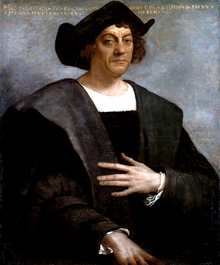
Christopher Columbus. The great explorer of the Americas. Not only did he bring two continents to Europe's attention (although he always believed he had found South-East Asia) he also saw something strange.
At 10pm, 11 October 1492, somewhere in the Atlantic Ocean, often believed to be near Watling's Island, a strange light was spotted in the distance by a number of crew members, including Columbus himself. The light was described as that of a candle, that moved up and down. The voyagers believed this to indicate land and followed the light to, what is now, Guanahani in the Bahamas. The identity and precise location of this light have been debated to this day.
One explanation is that it was a torch or other light brandished by a native American hunting, either on land or in a canoe on the water. However, Columbus' log mentions that the wind was very high and so this is considered unlikely. Another, more unusual explanation, is that the light could have been caused by bioluminescent protozoa that sometimes covers the rocks in the area. But, Columbus and his crew reported the light as being like a candle flame that moved, rather than an immobile glowing blob. Finally, a similar explanation could be the worm Odontosyllis enopla, a Caribbean species that glows during the mating season. But again, this explanation has a problem - Odontosyllis enopla only glows for a few days after the full moon and Columbus' log notes that the moon was only in its first quarter phase that night.
My thoughts: I have no explanation for this. Maybe they were mistaken or perhaps it was an optical illusion or a reflection in the water from something? Who knows?
See also:
More mysteries
At 10pm, 11 October 1492, somewhere in the Atlantic Ocean, often believed to be near Watling's Island, a strange light was spotted in the distance by a number of crew members, including Columbus himself. The light was described as that of a candle, that moved up and down. The voyagers believed this to indicate land and followed the light to, what is now, Guanahani in the Bahamas. The identity and precise location of this light have been debated to this day.
One explanation is that it was a torch or other light brandished by a native American hunting, either on land or in a canoe on the water. However, Columbus' log mentions that the wind was very high and so this is considered unlikely. Another, more unusual explanation, is that the light could have been caused by bioluminescent protozoa that sometimes covers the rocks in the area. But, Columbus and his crew reported the light as being like a candle flame that moved, rather than an immobile glowing blob. Finally, a similar explanation could be the worm Odontosyllis enopla, a Caribbean species that glows during the mating season. But again, this explanation has a problem - Odontosyllis enopla only glows for a few days after the full moon and Columbus' log notes that the moon was only in its first quarter phase that night.
My thoughts: I have no explanation for this. Maybe they were mistaken or perhaps it was an optical illusion or a reflection in the water from something? Who knows?
See also:
More mysteries
No comments:
Post a Comment